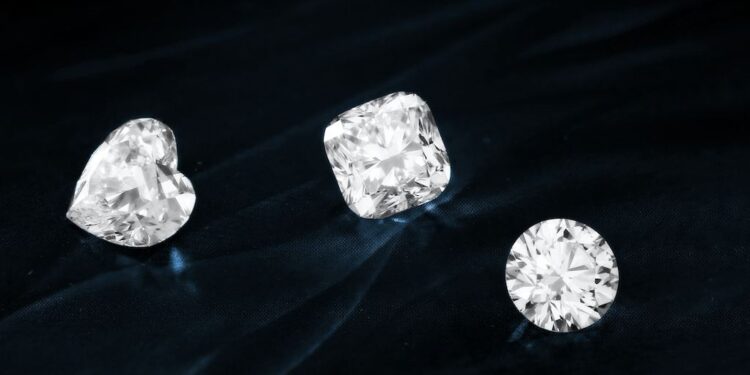Introduction
Diamonds are one of the most sought-after gemstones in the world, prized for their beauty, durability, and rarity. Most people don’t know the different varieties of diamonds available in the market. However, people with a lack of knowledge end up buying poor-quality diamonds that are not worth the money. This article explores the different types of diamonds based on consumer and technical categories, so you can better understand the characteristics and value of each type.
Types of Diamonds based on Consumer Wise
Natural Diamonds
Natural diamonds are formed deep within the earth’s crust over millions of years through intense heat and pressure. These diamonds are mined from the earth and are prized for their rarity, beauty, and durability. Natural diamonds are available in a range of colors and sizes, and their value is determined by their quality, which is measured by the 4Cs: carat weight, color, clarity, and cut. While natural diamonds are considered the most traditional and prestigious choice for diamond jewelry, they can also be the most expensive due to their rarity.
Lab Created Diamonds
Manufactured diamonds, also known as synthetic diamonds, are made in a controlled laboratory setting using advanced technology that mimics the natural diamond formation process. These diamonds have the same chemical, physical, and optical properties as natural diamonds and are nearly indistinguishable from the naked eye. Artificial diamonds are often more affordable than natural diamonds, making them a popular choice for those on a budget. They are also a responsible choice for those looking for an eco-friendly and ethical alternative to mined diamonds.
Treated Diamonds
Treated diamonds are natural diamonds that have undergone various treatments to enhance color, clarity, or overall appearance. These treatments can include irradiation, heat treatment, and fracture filling. Treated diamonds are often more affordable than natural diamonds but may be less durable or stable. Therefore, disclosing any treatments a diamond has undergone is important, as it can affect its value and durability.
Colored Diamonds
Colored diamonds, also known as fancy-colored diamonds, are natural diamonds with a distinct color other than white or colorless. These diamonds are in various colors, including yellow, pink, blue, green, red, and black. Colored diamonds are often rarer and more valuable than white diamonds due to their unique coloration. The value of a colored diamond is determined by the intensity and rarity of its color. But its size and overall quality also affect the total cost. Colored diamonds are highly sought after by collectors and jewelry enthusiasts and are a unique and stunning choice for diamond jewelry.
Types of Diamonds Based on Technical Wise
In addition to the consumer-based categories of diamonds, diamonds can be classified based on their technical characteristics. There are four main types of diamonds based on technical characteristics:
Type Ia Diamonds
Type Ia diamonds are the most common type of diamond, making up around 98% of all diamonds. They have many nitrogen atoms in their crystal structure, giving them a yellow or brown tint. Type Ia diamonds can also contain inclusions or imperfections that can affect their clarity.
Type IIa Diamonds
Type IIa diamonds are a rare type of diamond that makes up only around 1-2% of all diamonds. These diamonds are almost or entirely nitrogen-free, making them chemically pure and often colorless. Type IIa diamonds are highly valued for their purity and brilliance.
Type Ib Diamonds
Type Ib diamonds are similar to Type Ia diamonds but contain fewer nitrogen atoms. These diamonds can have a yellow or brown tint and may contain inclusions. Type Ib diamonds are less common than Type Ia diamonds but still make up a significant portion of all diamonds.
Type IIb Diamonds
Type IIa diamonds are known for their exceptional purity and are often colorless. These diamonds are the most chemically pure and contain very little to no nitrogen atoms. They also have a unique crystal lattice structure, making them incredibly hard and durable. As a result, they are highly prized and sought after by collectors and jewelry enthusiasts alike. Some of the world’s most famous diamonds, such as the Cullinan and the Koh-i-Noor, are Type IIa diamonds. Due to their rarity and high quality, Type IIa diamonds command some of the highest prices in the diamond market. Type IIa diamonds are particularly prized as they are sourced ethically and sustainably, making them a responsible and eco-friendly choice for consumers.
Bottomline
In conclusion, there are several different types of diamonds, each with unique characteristics and value. Consumers can choose from natural, artificial, treated, and colored diamonds, each with its own benefits and drawbacks. Technical classifications of diamonds include Type Ia, Type IIa, Type Ib, and Type IIb diamonds, each with its chemical composition and rarity. When choosing a diamond, it’s important to consider both the consumer and technical aspects of the stone.
Understanding the different types of diamonds and their respective qualities can help you make an informed decision and ensure you get the best value for your investment. Additionally, choosing an ethical lab-grown diamond can provide peace of mind, knowing that your diamond is sourcedin a way that is friendly to the planet.
With so many options available, it’s important to research and works with a reputable diamond dealer or jeweler to ensure you get a high-quality, authentic diamond that meets your needs and expectations. So, what are you waiting for? Explore your options online, and compare across different brands to find the best match for you.







